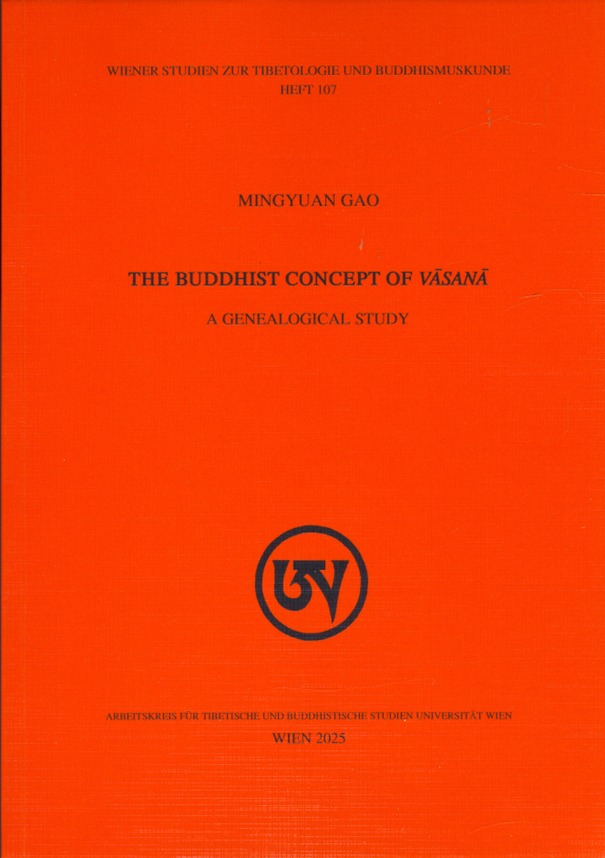The Buddhist Concept of Vāsanā - A Genealogical Study

The Buddhist Concept of Vāsanā - A Genealogical Study
Author: Dr Mingyuan Gao
Publisher: Wiener Studien zur Tibetologie und Buddhismuskunde (WSTB)
ISBN: 978-3-902501-45-5
Contents Preface
ix Abbreviations and Sigla
1. Introduction
1.1. Research Questions: The Complexity of Vāsanā
1.2. Etymological Analysis of Vāsana
1.3. Tibetan and Chinese Translations of Vāsanā
1.4. Various Connotations of Vāsanā
1.5. Literature Review
1.5.1. Vāsanā in the Pāli Sources
1.5.2. On Kleśavāsanā
1.5.3. On Karmic Vāsanā and Vāsanā of Conditioned Dharma
1.5.4. On Śrutavāsanā as the Seed of Supramundane Purification
1.6. Outlines of Each Chapter and Research Methodology
2. Vāsanā as the Imprint of Practice in the Pāli Literature
2.1. Vāsanā Related to Mundane Cultivation in the Suttanipāta
2.2. Peṭakopadesa and Nettippakaraṇa
2.3. Milindapañha
2.4. Concluding Remarks
3. Vāsanā That Preserves Karmic Efficacy
3.1. Vāsanā in Connection with Avijñapti in the Mahāvibhāṣā
3.2. Karmic Vāsanā, Vasubandhu’s “Saṃtati-pariṇāma-viśeṣa”, Śrīlāta’s “Anudhātu”, and Saṅghabhadra’s Refutation
3.3. Karmic Vāsanā in the Yogācārabhūmi
3.3.1. Preliminary Discussion in the Śrāvakabhūmi and Bodhisattvabhūmi
3.3.2. Karmic Vāsanā in the Savitarkasavicārādibhūmi
3.3.2.1. Vāsanā as Projection Cause (ākṣepa-hetu)
3.3.2.2. Simultaneous Impregnation (paribhāvanā) in the Savitarkasavicārādibhūmi
3.3.3. Karmic Vāsanā in the Viniścayasaṃgrahaṇī
3.4. Asaṅga’s Further Discussion of Karmic Vāsanā
3.5. Concluding Remarks
4. Vāsanā as the Impregnation of Conditioned Dharmas
4.1. Vāsanā Related to Meditative Cultivation in Abhidharm
4.1.1. Flowers Perfume Sesame
4.1.2. Association of Meditative Vāsanā with the Simile of Seed in the *Tattvasiddhiśāstra
4.2. Vāsanā of All Conditioned Dharmas and Bīja of All Dharmas
4.2.1. Yamabe’s Hypothesis
4.2.2. Contextual Shift of Impregnation from Abhidharma to Yogācāra
4.2.3. The Simultaneity of Bīja and Manifested Dharma and the Simultaneous Mode of Impregnation
4.3. Impregnation (vāsanā) and Conceptualization (vikalpa)
4.3.1. Vāsanā and Vyavahāra within the Framework of Trisvabhāva
4.3.2. Mutual Causation between Vikalpa and Vastu/nimitta
4.3.3. Vikalpa and the Three Types of Vāsanā in the Mahāyānasaṃgraha
4.4. Concluding Remarks
5. Kleśavāsanā: from Traces Left Behind by Defilements to Imprints Impregnated by Defilements
5.1. Early Sources of Kleśavāsanā
5.1.1. A Canonical Source
5.1.2. Sectarian Sources: Mahāsaṅghika and Vibhajyavāda
5.1.3. Akliṣṭājñāna and Mahādeva’s Position
5.2. Kleśavāsanā in the Sarvāstivāda School
5.2.1. Adoption of “Kleśavāsanā” in the Mahāvibhāṣā
5.2.2. The Vaibhāṣika Development of “Kleśavāsanā” in the Time of Vasubandhu
5.2.2.1. Abhidharmakośabhāṣya and Its Commentaries
5.2.2.2. Saṅghabhadra’s Refutation of Two Contemporary Theories about Vāsanā
5.2.2.3. Saṅghabhadra’s Vaibhāṣika Analysis of Kleśavāsanā
5.2.2.4. Bhadanta Rāma’s Theory of Non-defiled Vāsanā
5.3. Kleśavāsanā in Early Mahāyāna Texts
5.4. Kleśavāsanā in the Early Yogācāra School
5.4.1. Vāsanā and Jñeyāvaraṇa in the Oldest Layer of the Yogācārabhūmi
5.4.2. Vāsanā and Dauṣṭhulya in the Yogācārabhūmi
5.5. Vāsanā in the Tathāgatagarbha Literature
5.5.1. Śrīmālādevīsiṃhanāda-nirdeśa
5.5.2. Ratnagotravibhāga and The Mahāyāna Treatise on the Non-difference of the Dharmadhātu
5.5.3. Are There Remaining Traces (vāsanā) after Abandoning Jñeyāvaraṇa?
5.6. Vāsanā in Relation to Defilements in the Developed Yogācāra School
5.6.1. Ātmadṛṣṭivāsanā in the Mahāyānasaṃgraha
5.6.2. Kleśavāsanā Implied in Jñeyāvaraṇa
5.6.2.1. Jñeyāvaraṇa Explained in the Triṃśikāvijñapti-bhāṣya
5.6.2.2. Dharmapāla’s Analysis of Jñeyāvaraṇa Integrated with the Concept of Avidyāvāsabhūmi
5.6.2.3. Jñeyāvaraṇa in the Context of Āśrayaparivṛtti
5.7. Concluding Remarks
6. Śrutavāsanā, the Impression of Hearing the True Dharma
6.1. Mokṣabhāgīya and Śrutavāsanā
6.1.1. The Sarvāstivāda Concept of Mokṣabhāgīya
6.1.2. From Mokṣabhāgīya to Śrutavāsanā
6.2. Gotra and Śrutavāsanā
6.2.1. Primordial and Engendered Bījas
6.2.2. *Tathatālambanapratyaya, *Tathatālambanapratyaya-bīja and Śrutavāsanā
6.2.3. Mokṣabhāgīya and Gotra
6.3. Śrutavāsanā and Memory
6.4. Vāsanā of Pure Dharmas
6.5. Concluding Remarks
7. Doctrinal Synthesis of Vāsanā
7.1. Three Types of Vāsanā in the Mahāyānasaṃgraha
7.1.1. The Epistemological Scope of the Three Types of Vāsanā
7.1.2. The Trichotomy concerning the Vāsanā in Ālayavijñāna
7.2. Vāsanā in the Triṃśikāvijñaptibhāṣya
7.2.1. From Asaṅga’s Threefold Vāsanā to Vasubandhu’s Twofold Vāsanā
7.2.2. Sthiramati’s Interpretation 1: Vipākavāsanā and Niṣyandavāsanā
7.2.3. Sthiramati’s Interpretation 2: Ātmādivikalpavāsanā and Rūpādivikalpavāsanā
7.3. Integrated Use of Vāsana in the Laṅkāvatāra-sūtra
7.4 Concluding Remarks
8. Conclusion
Appendix: Chronology of Major Scriptures
Bibliography
Index
